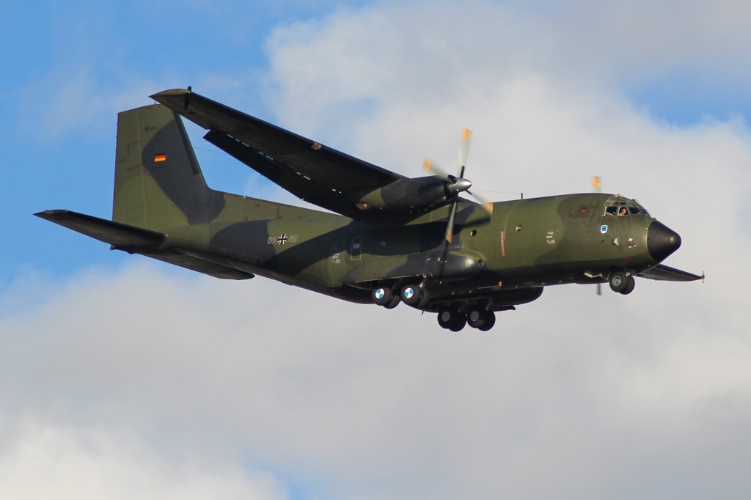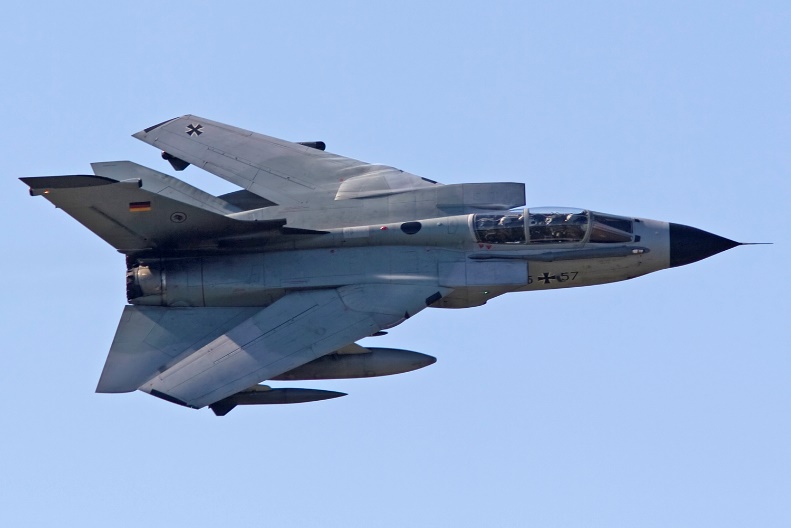German Air Force
The modern Luftwaffe, while named the same as its forbearers of World War Two does not draw any continuity earlier than 1956. Although struggling after unification and some internal strife, the Germans retain over 500 front line combat aircraft. Some like the modernized F-4 ICE are nearing the end of their lifespan but with the troubled Eurofighter program not yet producing a replacement, more modern aircraft such as the Tornado are carrying a heavy load in the Luftwaffe. Organizationally air units were grouped in wings, geschwader or Marineflieger with two squadrons (staffel) each.
Upon reunification of Germany in 1990 a significant reorganization took place. Most of the aircraft of the former German Democratic Republic (GDR, or East Germany) were passes to Czechoslovakia to hold, in an agreement with the Soviet Union – pending final disposition. Since then over 250 MiG 21’s, 65 MiG-23’s, 50 Su-22’s, 50 L-39’s, almost 200 helicopters and over 250 SAM systems have found their way into other militaries mostly in Africa but also in South and Central America. The key exception was the two dozen modern MiG-29s which the GDR received only a year before the collapse of its government; these have been fully integrated into the Luftwaffe and have been used extensively by the US and other NATO nations for training. The German MiG pilots are probably the best in the world after four years of force on force training against the finest air forces in the alliance.
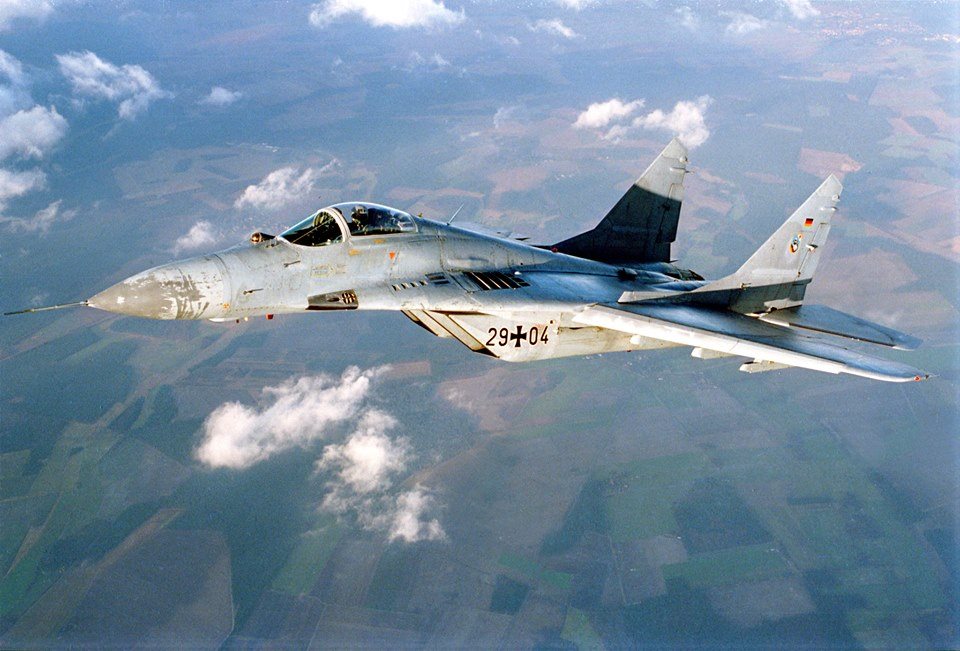
The Soviet built MiG-29’s are the most modern aircraft in the German inventory. They are highly maneuverable multi-role aircraft which have done outstanding service conducting DACT (Dissimilar Air Combat Training) with many NATO nations. Used as aggressors on almost every major NATO exercise since 1990, the pilots of Jagdgeschwader(JG) 73 (Fighter Wing 73) became extremely adept at air to air combat. All 24 of these aircraft, including 4 twin seat training variants were maintained in the 1st Squadron 73 JG (1/73 JG)
The Tornado is a result of a Tri-national (British, German and Italian) effort to replace aging, primarily American aircraft in the 80’s and early 90’s. This was a highly successful endeavour with almost 1000 aircraft produced in three variants. The Luftwaffe procured 160 Tornado IDS (Interdiction/Strike) and 34 Tornado ECR (Electronic Combat/Reconnaissance), while the German Navy (Bundesmarine) acquired 112 IDS variants which are included here. No Air Defence Variants (ADV) were purchased by Germany who were banking on the Eurofighter Typhoon for the air superiority role. That aircraft was yet to make its first flight (March 1994). The intention was that the IDS version would replace all Alpha Jets an F-4F Phantoms in the Fighter Bomber role, however due to increased tensions one wing of Phantoms was retained and two wings of Alpha Jets were kept in front line service. Fighter bomber wings are named Jagdbombergeschwader (JBG)
The Bundesmarine maintains two wings (Marineflieger or MFG) of 48 aircraft each, specializing in the marine strike role with AS.34 Kormoran Anti-ship missiles.
The Operational Conversion Unit for this type is maintained in the US at Holloman AFB.
| Sqn | Name | Location | No. | Type |
|---|---|---|---|---|
| 1/31 JBG | Boelcke | Norvenich | 18 | Tornado IDS |
| 2/31 JBG | Boelcke | Norvenich | 18 | Tornado IDS |
| 1/32 JBG | Tiger | Lechfeld | 18 | Tornado IDS |
| 2/32 JBG | Tiger | Lechfeld | 14 | Tornado ECR |
| 1/33 JBG | Hawk | Buchel | 18 | Tornado IDS |
| 2/33 JBG | Hawk | Buchel | 18 | Tornado IDS |
| 1/34 JBG | Allgäu | Memmingen | 18 | Tornado IDS |
| 1/34 JBG | Allgäu | Memmingen | 18 | Tornado IDS |
| 1/38 JBG | Friesland | Jever | 18 | Tornado IDS |
| 2/38 JBG | Friesland | Jever | 16 | Tornado ECR |
| 1/39 JBG | Erding | 12 | Tornado IDS | |
| 1/MFG 1 | Sea Hawks | Nordholtz | 24 | Tornado IDS |
| 1/MFG 1 | Sea Hawks | Nordholtz | 24 | Tornado IDS |
| 1/MFG 2 | Eggebek | 24 | Tornado IDS | |
| 2/MFG 2 | Eggebek | 24 | Tornado IDS |
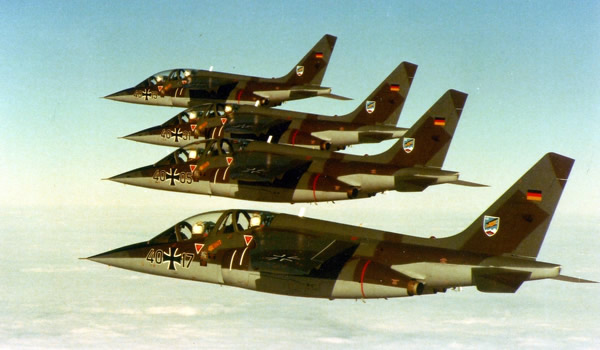
Primarily an advanced jet trainer, the Luftwaffe chose to us this aircraft in the light attack role to replace the Fiat G91. Although used as a weapons training platform in Beja Portugal, most advanced training for the Luftwaffe was conducted in the US using American facilities and aircraft. In 1993 an agreement with Portugal for the continued use of Beja included passing 50 Alpha Jets to that country, this deal was kept but further sales of Alpha Jets were cancel and two wings were maintained in front line service.
| Sqn | Location | No. | Type |
|---|---|---|---|
| 1/49 JBG | Fürstenfeldbruck | 18 | Alpha Jet |
| 2/49 JBG | Fürstenfeldbruck | 18 | Alpha Jet |
| 1/43 JBG | Oldenburg | 18 | Alpha Jet |
| 2/43 JBG | Oldenburg | 18 | Alpha Jet |
| 1/44 JBG | Beja Portugal | 18 | Alpha Jet |
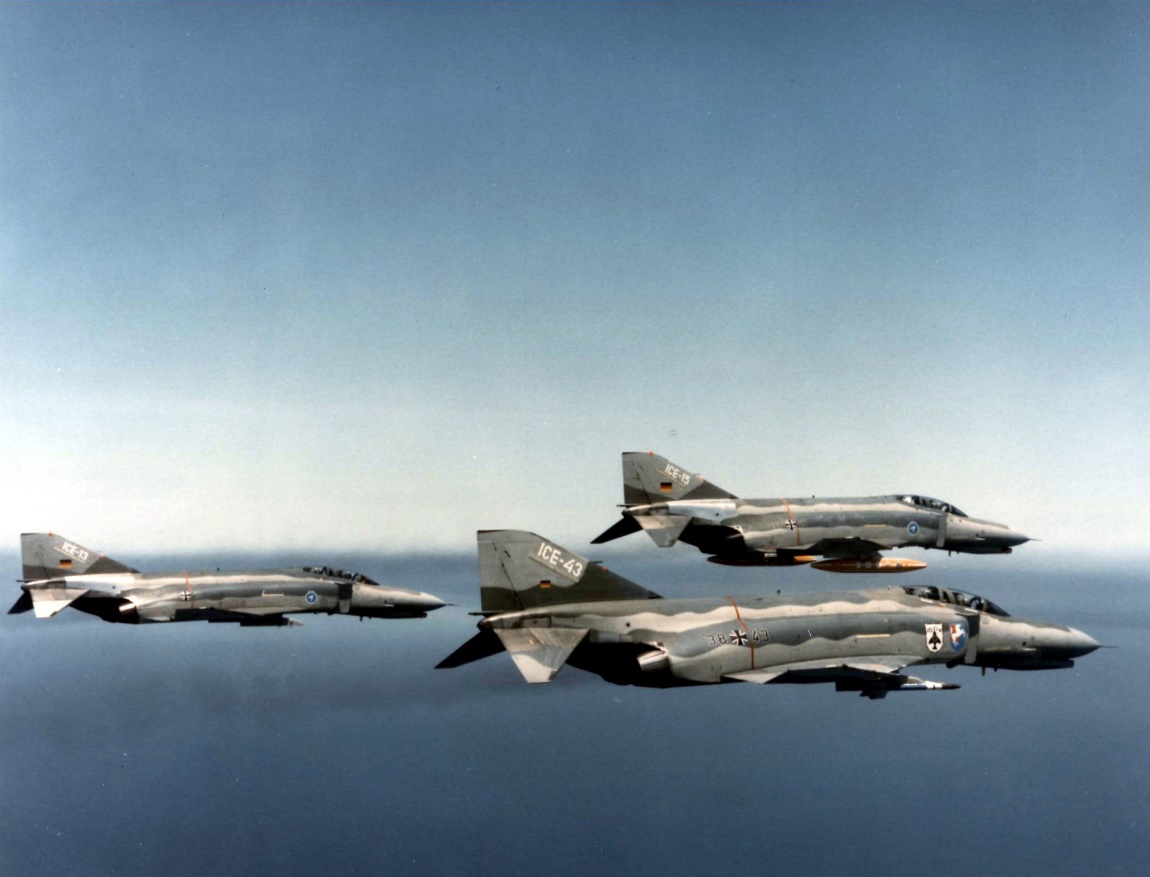
Germany used the F-4 extensively from 1971 onwards, originally operating 175 F-4F’s and 88 RF-4E’s operationally and several F-4E’s for training in the US. In order to fill the critical Air-to-Air shortfall in the Luftwaffe while the Eurofighter was being developed the venerable F-4F underwent a modernization program – ICE (Improved Combat Efficiency). The two most significant improvements were the addition of the modern APG-65 radar and the ability to fire AIM-120 AMRAAM BVR (Beyond Visual Range) missiles. 110 conversions were authorized and by the start of Northern Fury 80 had been completed, slightly quicker than historic where 70 had been converted by the end of 94. The major drawback however was the lack of the AIM-120 missile, Germany only ordered 96 for delivery in 2005, leaving the Phantoms to use AIM-7 Sparrows and AIM-9L Sidewinders. Two and a half wings of Phantom-ICE were in operations (JG 73 operating one Staffel of MiG-29 and one of F-4 ICE) while three other wings were using the un-modified F-4F’s.
The other key roles of the Phantom were strike bombing and reconnaissance. Two full wings of RF-4E were relied on to provide intelligence and BDA (Bomb Damage Assessment) using photo, Infrared and SLAR (Side Looking Airborne Radar). The preferred method of operation was low and fast.
| Sqn | Name | Location | No. | Type |
|---|---|---|---|---|
| 1/35 JBG | Memmingen | 18 | F-4F | |
| 2/35 JBG | Memmingen | 18 | F-4F | |
| 1/36 JBG | Hopsten | 18 | F-4F | |
| 2/36 JBG | Hopsten | 18 | F-4F | |
| 1/51 AG | Immelman | Bremgarten | 18 | RF-4E |
| 2/51 AG | Immelman | Bremgarten | 18 | RF-4E |
| 1/52 AG | Leck | 18 | RF-4E | |
| 2/52 AG | Leck | 18 | RF-4E | |
| 1/71 JG | Richthofen | Witt~mund | 16 | F-4F ICE |
| 2/71 JG | Richthofen | Witt~mund | 16 | F-4F ICE |
| 1/72 JG | Westfalen | Hopsten | 18 | F-4F |
| 2/72 JG | Westfalen | Hopsten | 18 | F-4F |
| 2/73 JG | Steinhoff | Laage | 16 | F-4F ICE |
| 1/74 JG | Molders | Neuburg | 16 | F-4F ICE |
| 2/74 JG | Molders | Neuburg | 16 | F-4F ICE |
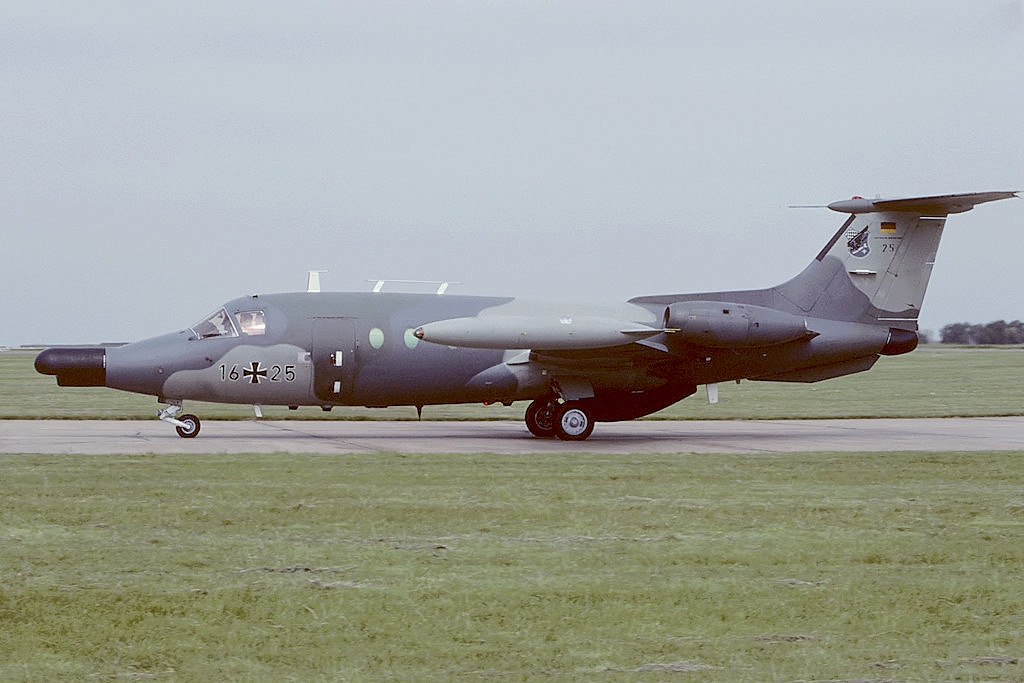
Eight of these rather odd business jets were used by the Luftwaffe for Electronic Countermeasures training and operations from the early 70’s. There are seven remaining at the start of 1994, the year in which they were supposed to retire. They form the 3rd Staffel of JG 32 based at Lechfeld.
C-160D Transall
This twin engine tactical transport produced by France and Germany. Carrying almost as much as a C-130 Hercules, but over much shorter ranges, the Transall was perfectly suited the intra-theater transport tasks it was designed for. The Luftwaffe acquired 90 of the ‘D’ models (another 20 went to Turkey) in the late 60’s and grouped them in three transport wings (Lufttransportgeschwader, or LTG).
| Wing | Location | No. | Type |
|---|---|---|---|
| 61 LTG | Penzing | 24 | C-160 |
| 62 LTG | Wunsdorf | 24 | C-160 |
| 63 LTG | Hohn | 24 | C-160 |
